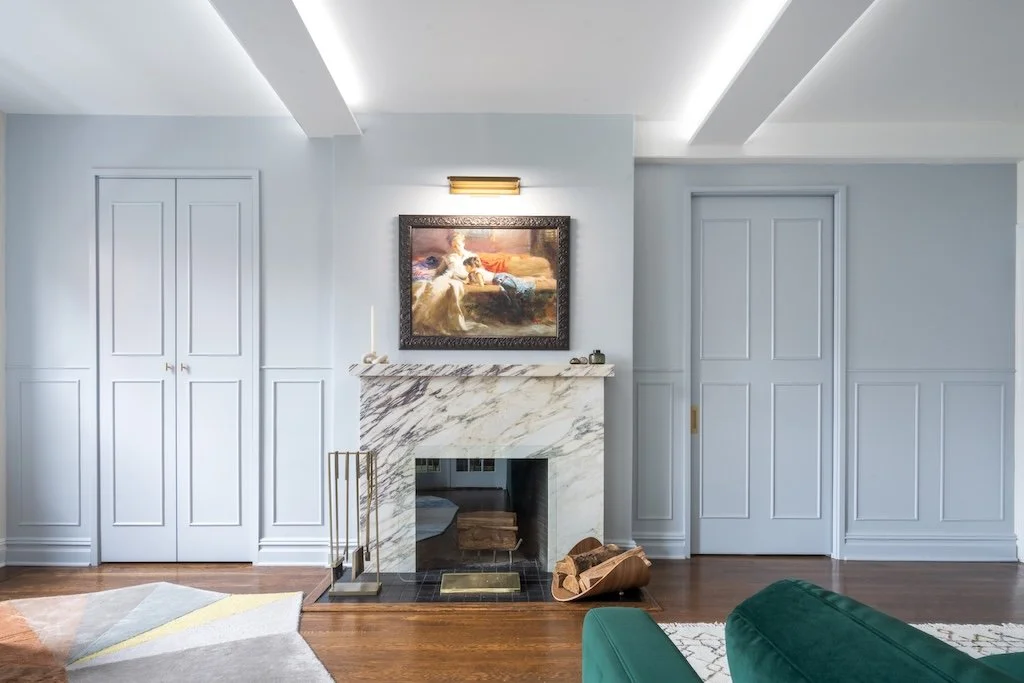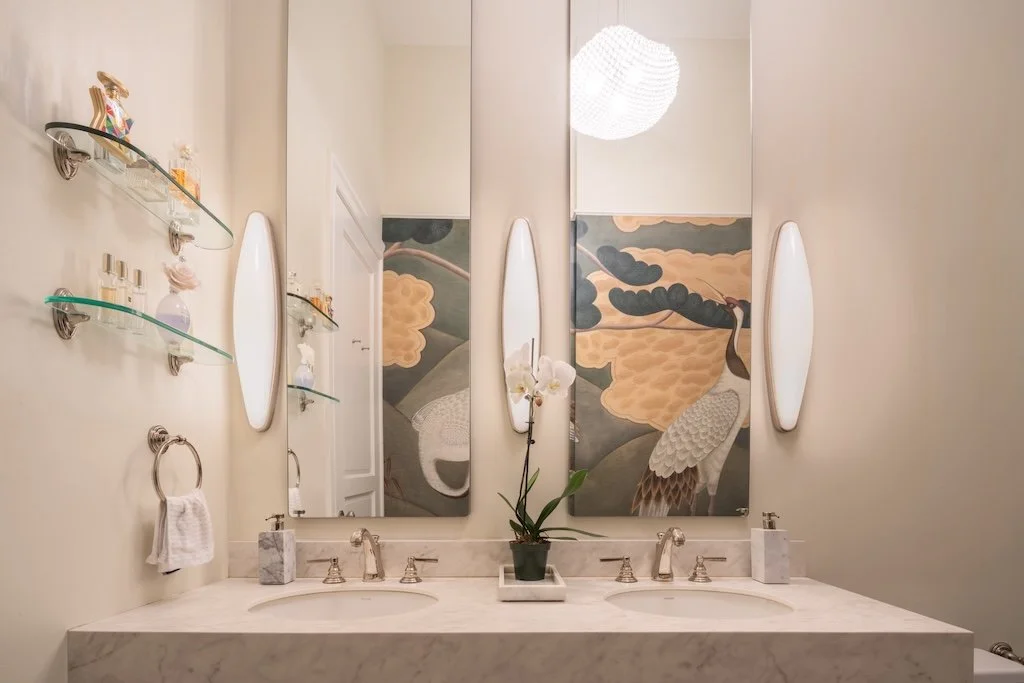Reimagining Tudor Homes with Modern Interior Design
What happens when historic charm meets modern clarity, without compromise?
Modern Tudor interior design is the answer for homeowners caught between two worlds. On one side, heavy beams, dark paneling, & awkward floor plans. On the other, clean lines, natural light, and the effortless flow we expect from a 21st-century home.
The challenge? Most Tudor renovations go too far. They strip away the character that made these homes unforgettable in the first place.
Here’s the good news: You don’t need to choose between history and livability. According to a recent Houzz survey, 83% of homeowners prioritize maintaining original character when renovating older homes. This guide walks you through how to reimagine a Tudor interior, keeping the best of the past, while upgrading the parts that no longer serve.
From layout shifts to material swaps, you’ll see how to make your Tudor home feel rooted, refined, and ready for right now.
What Makes a Tudor Home a Tudor Home?
(Take This In Before You Touch a Thing)
Tudor architecture hit its stride in the 1920s & '30s, with influence drawn from medieval English country homes. These houses were built with detail, texture, and drama in mind.
Interior features often include:
Ornate millwork & paneling
Dark wood beams (often massive & exposed)
Arched entries & niche doorways
Stone or brick fireplaces
Narrow, leaded windows, with diamond panes
Moody color palettes, deep greens, oxblood, or navy
This was a style made to withstand winters, both physically & emotionally. Solid. Stoic. Strong.
But in today’s world, we want light, flow, ease.
So, the question is: How do you keep that dramatic charm... but let the space breathe?
Modern Tudor Interior Design Starts with Subtraction
Modernizing doesn’t mean erasing, it means editing.
The best modern Tudor renovations don’t remove history. They reframe it.
Step 1: Lose the Excess (Not the Essence)
One of the most powerful moves? Lighten the palette, keep the texture.
Replace dark paneling with soft lime-washed plaster
Retain original ceiling beams but sand & bleach them
Swap heavy furniture for sculptural, low-profile pieces
Add clean-lined lighting, brass, blackened steel, or glass
In Alameda, California, interior designer Kelley Flynn took a Tudor bungalow & created a masculine, minimalist sanctuary using walnut, black marble, wool & leather. Her design didn’t compete with the house’s bones, it complemented them. Similarly, Sara Mosele Interiors often incorporates minimalist principles, letting the original architecture shine through in their luxury interior design projects in NYC & Westchester.
The result? Sophisticated. Grounded. True.
Open Up the Layout - But Don’t Overdo It
Original Tudor homes weren’t exactly open-concept. Instead, they featured cozy, compartmentalized spaces. That doesn’t mean you need to knock every wall down, but reconsider the flow.
In Westchester, New York, Dorothee Junkin tackled a poorly renovated Tudor Revival with a plan, not a sledgehammer. Instead of adding square footage, she played a “game of shuffle,” reworking space by removing awkward partitions & connecting rooms through wide, arching thresholds.
A recent Remodeling Magazine study found that selective interior alterations (like opening strategic walls) add significant value and functionality without disrupting historic integrity.
The key: Keep the shape of original arches, but update the finish. Instead of ornate trim, she used soft plaster edges, a subtle but stunning change.
Natural Materials + Light = Game Over
Let’s be honest, Tudors were built for coziness, not sunlight.
So if you want to bring the style forward, here’s your secret weapon: natural light + natural materials.
Designers are leaning into materials like:
Calacatta marble (used in thinner cuts, easier on floors & wallets)
Textured linens, jute & bouclé
Warm oak, for flooring, beams & vanities
Unlacquered brass fixtures
Whitewashed walls & oversized mirrors
In a reimagined Tudor in Silver Lake, California, vaulted ceilings clad in oak planks turned a once-shadowy living room into an airy, inviting space. Add in a kitchen with Calacatta Paonazzo marble & glass French doors to the backyard, and the whole vibe shifts.
Furniture Matters A Lot
Modern Tudor interior design doesn’t rely on fussy decor. The furniture does the talking.
Look for:
Bench seating under arched windows
Sofas with tailored arms in mohair or muted velvet
Live-edge dining tables paired with Danish-style chairs
Custom rugs (geometric or vintage patterns in soft tones)
Matte black & bronze accents (instead of polished silver)
It’s about contrast, not chaos. According to Elle Decor, furniture and decor that combine sleek modern lines with traditional craftsmanship perfectly align with modern Tudor aesthetics.
Old beams + new lines. Rough textures + sleek shapes.
That’s the modern Tudor language.
Color Is Coming Back - Slowly, Strategically
Modern doesn’t have to mean white. In fact, one way to stay true to a Tudor's soul is through color, just used more strategically.
Here’s what works:
Clay, taupe & sage on walls
Charcoal kitchen cabinets, paired with aged brass hardware
Deep forest green for built-ins
Oxidized blue in powder rooms
Blush or rust accents in upholstery
Think earth-inspired, not high contrast. The palette should feel lived-in, not showroom polished.
Bathrooms & Bedrooms - Where Modern Really Shines
Bathrooms in Tudors were rarely a design highlight. So here’s your moment to go all in.
Try:
Marble slab walls (just not too thick, weight matters)
Oversized rain showers with arched glass doors
Built-in vanities with vintage mirror pairings
Freestanding tubs under sloped eaves
Handmade tile, muted plaid, herringbone, or brushed zellige
And in the bedrooms? Add built-ins below windows, soft wall sconces, & antique rugs. Make it tactile, but not heavy.
Outdoor Connection Is Everything
A common Tudor flaw? Disconnected outdoor access. Remedy that, and the house will feel more modern.
Add French or steel doors from the kitchen to the garden
Create a sunroom or “morning room” with floor-to-ceiling glass
Use natural landscaping, boxwood, lavender, olive trees
Level sloped gardens where possible to allow lounging & play
Consider a pergola, simple, timeless, and incredibly effective
In one standout Silver Lake home, the back garden was completely regraded. The result? A firepit, spa, & pool now sit behind arched kitchen doors, and it feels seamless.
Final Word: You Don’t Have to Choose Between Past & Present
Modern Tudor interior design is the answer to a question many homeowners face: Can I have charm & function? Character & comfort?
Yes. Absolutely yes.
You can live with old-world structure, and still enjoy new-world flow. You can celebrate your home's history, without getting stuck in it.
These homes weren’t built for speed or trend. They were built with intention. So when you redesign them, do the same.
Let the bones breathe. Bring in the light. Simplify the story, without losing the plot.
Because Tudor style doesn’t need a makeover.
It needs a comeback.
Frequently Asked Questions
-
Modern Tudor interior design blends traditional Tudor architectural features, like exposed wood beams, arched doorways, and leaded windows, with clean lines, lighter palettes, and updated layouts for a more livable, contemporary feel.
-
To modernize a Tudor-style home, keep key architectural elements intact (like beams or brickwork) while updating interiors with open layouts, natural light, minimalist furnishings, and neutral tones to balance old with new.
-
Yes, mixing modern furniture with Tudor architecture creates a striking contrast. Choose low-profile pieces, sculptural lighting, and soft textures that complement rather than overpower the home’s historic character.
-
Earthy tones like clay, sage, ivory, and charcoal work best in a modern Tudor home. These colors enhance natural light, soften heavy wood accents, and bring balance to traditional features.
-
Modern Tudor interiors often replace traditional dark wood paneling with lighter wood tones or textured plaster to preserve warmth while creating a brighter, more modern aesthetic.
-
It can be, due to the balance of preserving original materials and adding custom finishes.
However, thoughtful updates like repurposing spaces and choosing sustainable materials can keep costs reasonable.
-
To brighten a Tudor home, use neutral paint, widen archways, install larger windows or doors where possible, and incorporate mirrors and lighter flooring to reflect more natural light.
Why Sara Mosele Design?
Ready to transform your NYC home into a space that truly reflects your lifestyle?
At Sara Mosele Interiors, we specialize in reimagining spaces with a blend of European elegance and New York practicality. Explore our Interior Architecture Services to see how we can bring your vision to life.
Welcome!
Hi, I’m Sara. I design spaces that speak to the soul - elevated, timeless, and deeply personal. With roots in Italian elegance and a home in New York sophistication, my work blends refined aesthetics with livable luxury. Whether it’s a city condo or a Westchester retreat, I believe every detail should serve a purpose and spark emotion.
Let's Connect
Have a question about design? Want to collaborate on a project? Or just curious about the stories behind our spaces? I’d love to hear from you.








